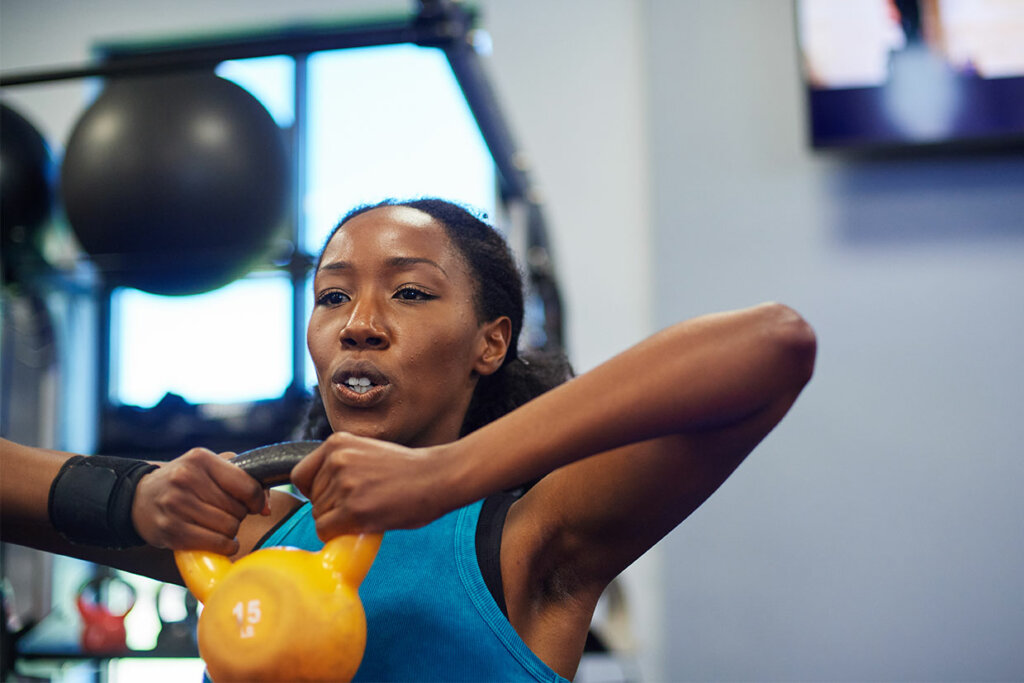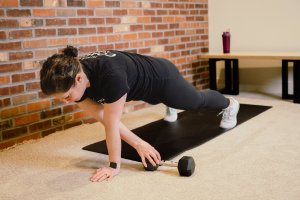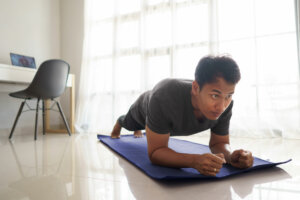If you ask our coaches what their favorite piece of free-form equipment is, they’ll most likely answer back with the kettlebell. Take Coach Catherine from AF Deltona, FL, who loves to sing the praises of its versatility: “It can be used it for ANY kind of exercise and muscle group,” she says. “Hitting legs? No problem, do some squats or walking lunges! Shoulder workout? Shoulder press or upright rows! It’s simple and effective.”
We’re going to take you through a 30-minute full-body circuit kettlebell workout session that’s sure to get the cardiovascular system pumping and the sweat flowing—but first, let’s review the basics.
What are kettlebells, anyway?
Kettlebells are free-form gym equipment, usually cast from iron or steel, and they have one rounded handle sprouting from the top. They come in standard weights and can be a great tool for reaching your fitness goals, when used smartly and safely.
A kettlebell exercise is one of the most comprehensive kinds of workouts you can do because it’s functional training, meaning it mimics movements you’re already doing in everyday life—like carrying heavy grocery bags or hoisting your kid in the air. How you use this equipment will influence the kinds of results you’ll see. Keep in mind that kettlebell workouts only deliver those full-body benefits when you are using them safely and correctly.
Origin of the kettlebell
While they didn’t gain popularity in North America until the late 1990s, kettlebells have been used in full-body strength training for centuries. Known as girya (the Russian word for kettlebell), they were initially manufactured as counterweights to measure goods in local markets in the early 18th century. It wasn’t long before people realized that these girya were great for demonstrating strength, and that using them in strength training resulted in some great health benefits. And because we humans have always loved competition, it also wasn’t long before villages and towns were holding strongman-like competitions at their festivals, with contests to see who could lift the heaviest bell.
What’s the difference between kettlebells and dumbbells?
If kettlebells and dumbbells were related, they’d probably be first cousins once removed. There are a few obvious (and non-obvious) differences between the two, starting with their shape. Kettlebells are weighted toward the bottom with the handle on top, whereas dumbbell weight is evenly distributed on the ends with a center-balanced handle. While they seem similar, their designs influence the movements you do with them. Since the weight is carried underneath the handle, kettlebells require more stability and core strength to lift because of their uncentered and unbalanced nature.
Benefits of using kettlebells in your workouts
You’ve probably guessed that you’re going to see a lot of strength gains when using a kettlebell to work out, but where that strength shows up might surprise you. According to a study by The American Council of Exercise (ACE), kettlebell training can result in a dramatic increase in your abdominal core strength. Because of that added strength in the mid-section, the study was also able to show how much their subjects’ balance had improved. ACE also found that kettlebell training can have a significant impact on aerobic capacity, with kettlebell workouts providing more cardio benefits than walking. If you’re looking for an efficient workout that works out three areas at once—full-body, core, and cardio—the kettlebell is a triple threat worth checking out.
How often should I be training with kettlebells?
As with anything else in life, kettlebells should be used in moderation. We’re not going to lie to you: It’s an intense workout. Because it engages so many muscles at once, it’s recommended a beginner start with two to three workouts a week. A 30-minute kettlebell session is really all you need but be sure to shake up your routine to work all your muscles evenly and avoid injury.
How do I keep my back safe while doing kettlebell exercises?
Kettlebell workouts are only as safe as you make them. With the right posture, proper form, and appropriate bells, your back and core will be in the clear. However, if you have the wrong setup, try exercises outside of your strength level, or train a muscle to failure, you’re just asking for an injury. The best thing to do during your full-body kettlebell workout is to keep your back straight, take it slow, and remember that seeing progress always takes time.
More kettlebell exercise safety tips
Before you get to swinging, here are some more tips to keep you safe:
- Don’t start alone. Get a couple training sessions with a coach or use a workout video to help maintain proper form.
- Lift with your legs. When getting into position, always lift with your lower body—not your arms, and especially not your back.
- Use your kettlebell as intended. While similar, you shouldn’t use a kettlebell in place of a dumbbell, and vice versa. They’re weighted differently and were designed for different purposes, and there’s no reason to take on the risk of injury.
How many pounds should my kettlebell weigh
The key to good kettlebell form is to start slow and carefully work your way up in weight. The size of the kettlebell you start with will depend on how much strength training you’ve been doing and how in shape you are. For women, it’s recommended to start with an 18-pound kettlebell, or a 26-pound bell if you’re already strength training. For men, it’s 26 pounds without training and a 35-pound kettlebell with training. Note: If you’re just starting out, use lighter weights so you can focus on your form before increasing the weight.
How are kettlebells measured?
Remember how we said the oldest mention of kettlebells being used in workouts was in ancient Russia? Their weight convention system is a carryover from their Russian origins, being classified in “poods,” which is an old Russian weight measurement. According to Greg Brookes of Kettlebell Workouts, kettles traditionally come in five common weights:
- 8 kg (0.5 pood)
- 12 kg
- 16 kg (1 pood)
- 2 4kg
- 32 kg (2 pood)
As kettlebells have grown in popularity, in-between weights like 20 kg and 28 kg have been produced to make the transition to a heavier weight more gradual.
How many kettlebells do I need to start?
The great thing about kettlebells is you only need one to start, and you can still get a great workout. It’s part of the reason why they’re so popular; they’re the perfect solution for home workouts or for when it gets too busy at the gym.
The best kettlebell for you will also depend on what workouts you’re doing, which is why it can be beneficial to meet with a coach who can guide you as you learn this new workout. If you’re a kettlebell newbie, there can be a learning curve to some of these moves. It can take days, weeks, even months to feel like a kettlebell swinging pro—just remember you got this.
The Best 30-Minute Full-Body Kettlebell Workout
We’re breaking down some of the best kettlebell exercises to do at the gym or in your home. These classic moves will have you building strength and shredding pounds in under half an hour, plus they’ll target most—if not all—of the muscle groups in your upper and lower body.
Reps, sets, and steps
To turn these six exercises into a strength- and circuit-training session, complete 10 repetitions of each movement with 30–60 seconds of rest in between each set. Remember: Use lighter weights to start so you can maintain controlled movements and focus on perfecting your form.
As you progress, continue with 10 repetitions, but cut down on time in between exercises to see how many sets you can get through in 30 minutes. You’ll see an increase in cardio demands when you keep your heart rate pumping. Okay, let’s get to swinging!
1. The Kettlebell Deadlift
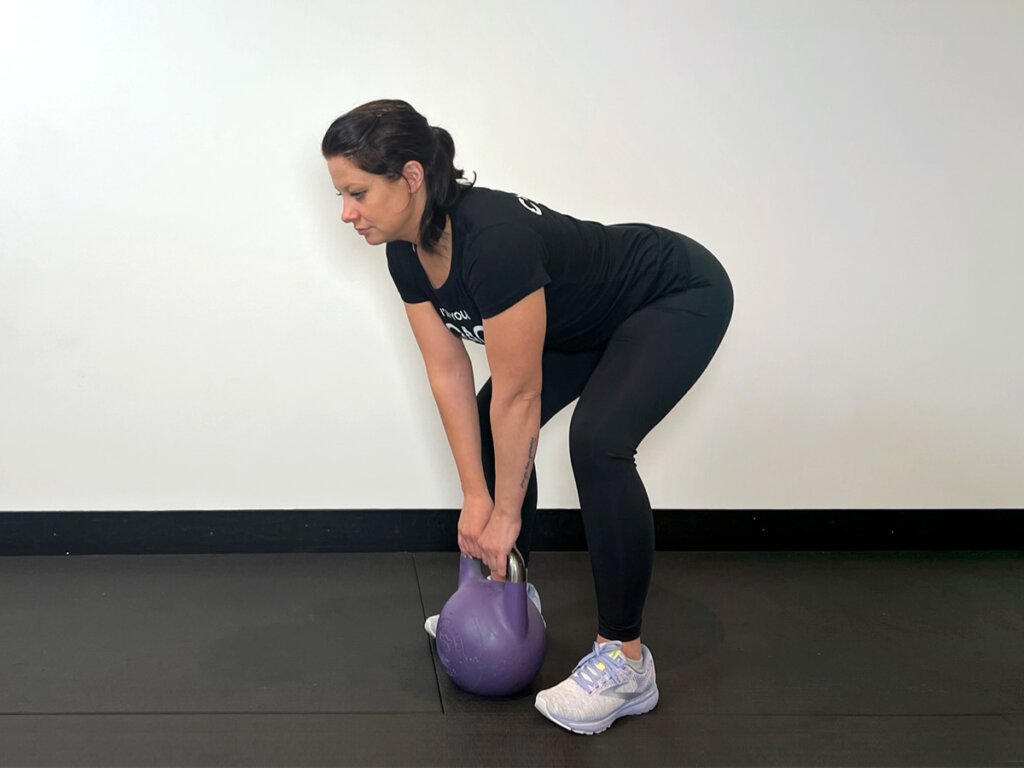
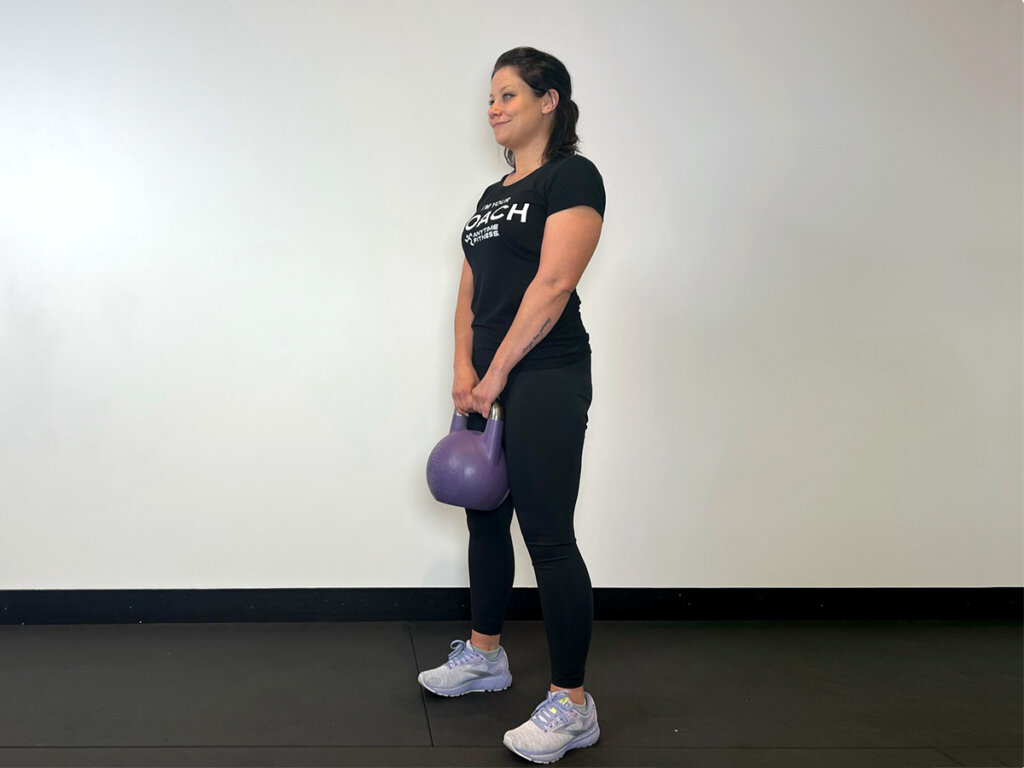
The kettlebell deadlift is a great way to get started with mastering the kettlebell swinging technique. This exercise will target each muscle group in your lower body as well as your lower back. It will also help you learn to initiate momentum from your hips—not your arms— protecting your back through good form.
- Place your feet shoulder-width apart, with the kettlebell resting on the ground between your feet. (Note that this is the starting position for a lot of the upcoming moves!)
- Squat down, keeping your chest upright and shoulder blades back. Keeping your arms straight, reach down and grab the kettlebell off the ground with both hands. Keep your head and chest up and your back straight.
- Press through your feet to come to a standing position as you engage your glutes and core muscles at the top. The kettlebell should rise naturally; don’t try to lift it with your arms.
- Return the kettlebell back to the floor between your feet by squatting back down.
2. The Kettlebell Swing
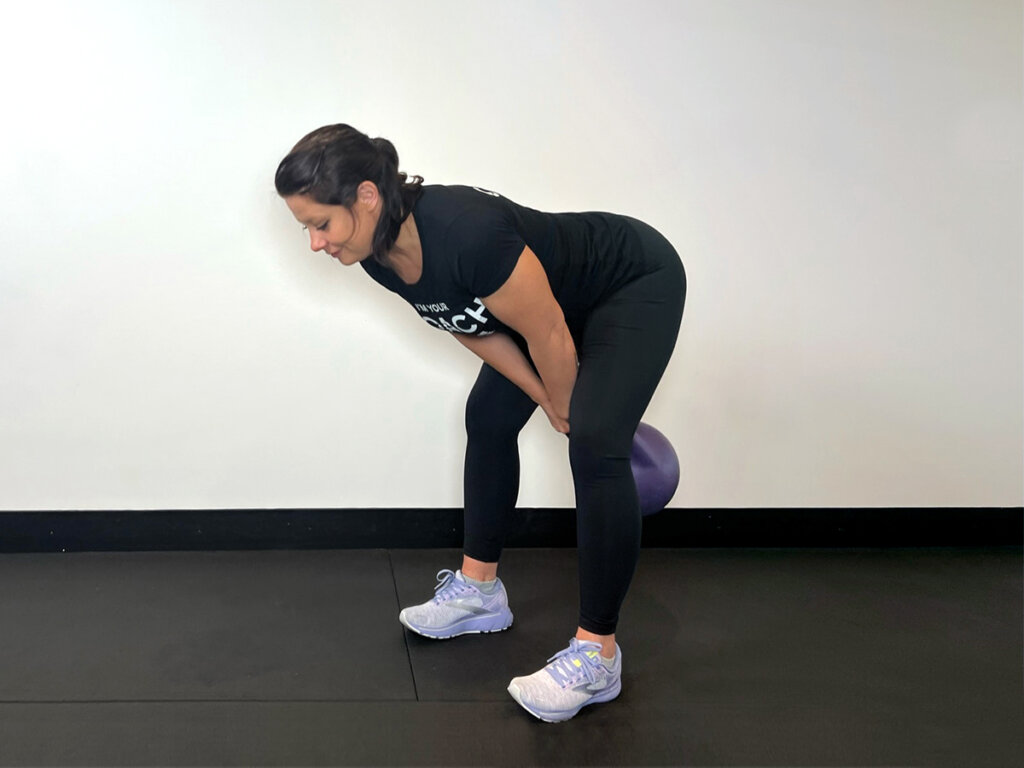
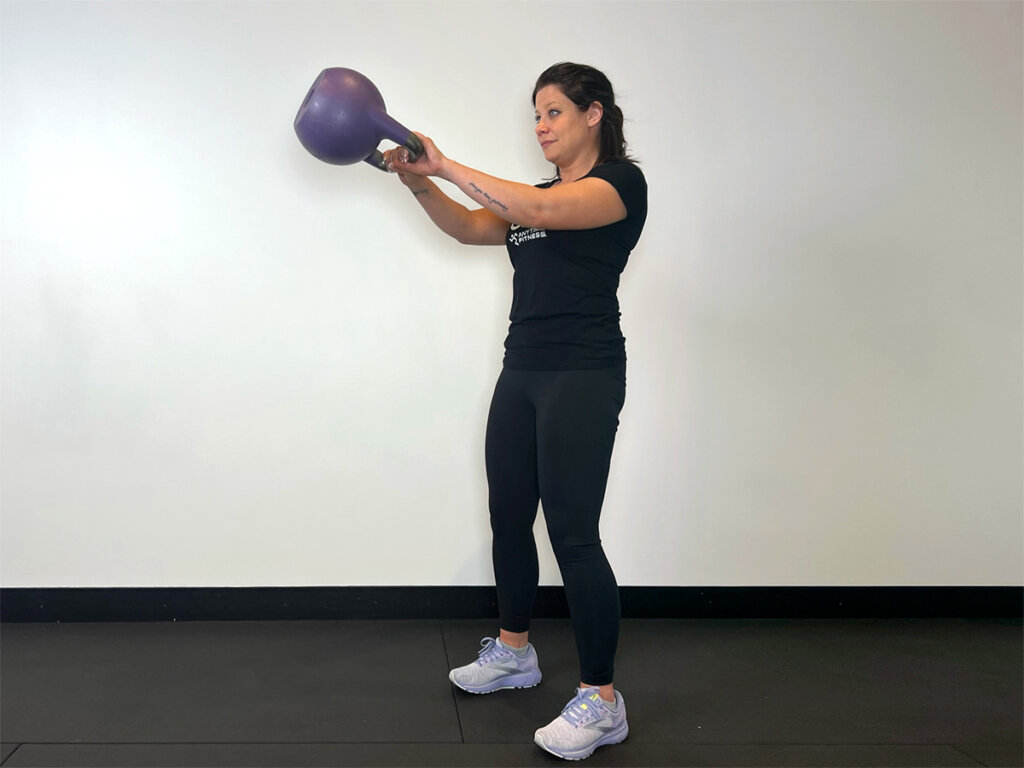
Meet the quintessential kettlebell move: The two-hand swing. This exercise teaches you to integrate your entire body to move the weight, hence why it’s one of our favorite moves to incorporate into full-body workouts. Keep in mind, this is not a squat, nor is it about lifting with your arms to get the kettlebell to shoulder height. This workout is about using the legs and hips to power the kettlebell effortlessly into momentum—you’ll be getting your heart rate up with this one.
- For starting position, your feet should be placed shoulder- to hip-width apart with the kettlebell on the floor just in front of you.
- Just like with the deadlift move, you’ll start by squatting and reaching down to grab the kettlebell with both hands, pushing your hips backwards as you do, making sure to keep your back straight and head up. Your arms should stay almost straight throughout the movement, with only a little bend in the elbows.
- Swing your arms up, hiking the kettlebell back through your legs and straight up to about chest height. Be sure to use the momentum generated from your hips and legs, not from your arms or back. When the kettlebell reaches chest height, it should momentarily feel lightweight and like it’s floating.
- With control, let the kettlebell fall back between your legs, but do not let it touch the floor. Congrats—that is one rep!
Swing progressions
Once you’ve mastered the basic form, progressions include single-hand swings and switching hands during the swing.
3. The Renegade Row
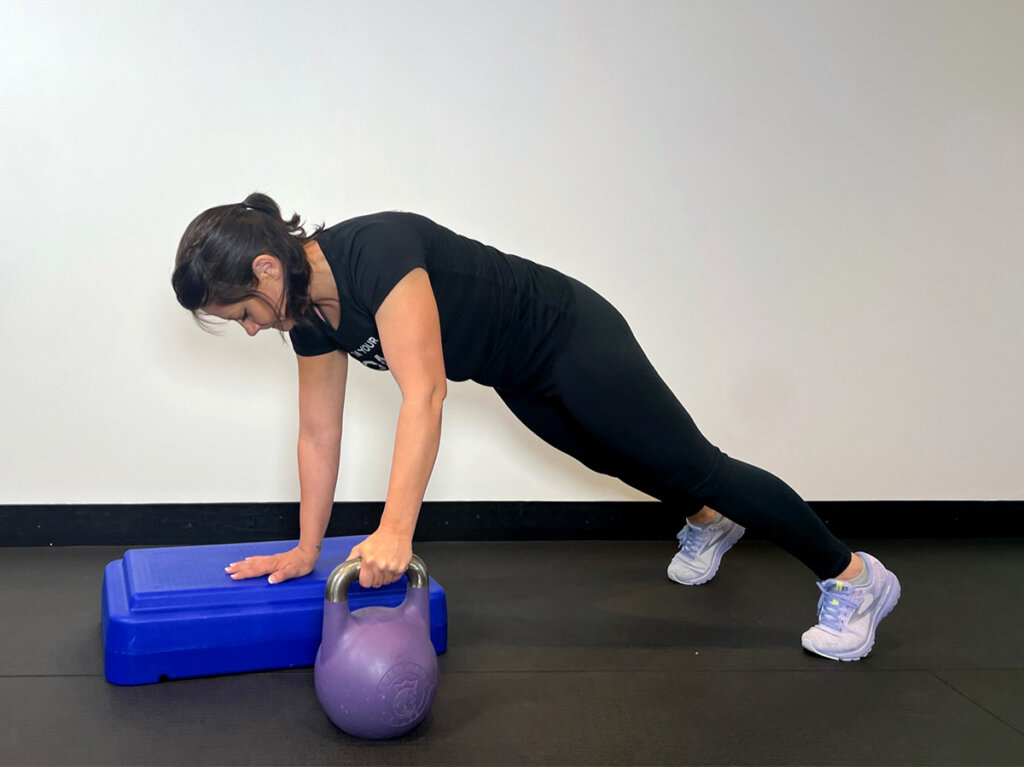
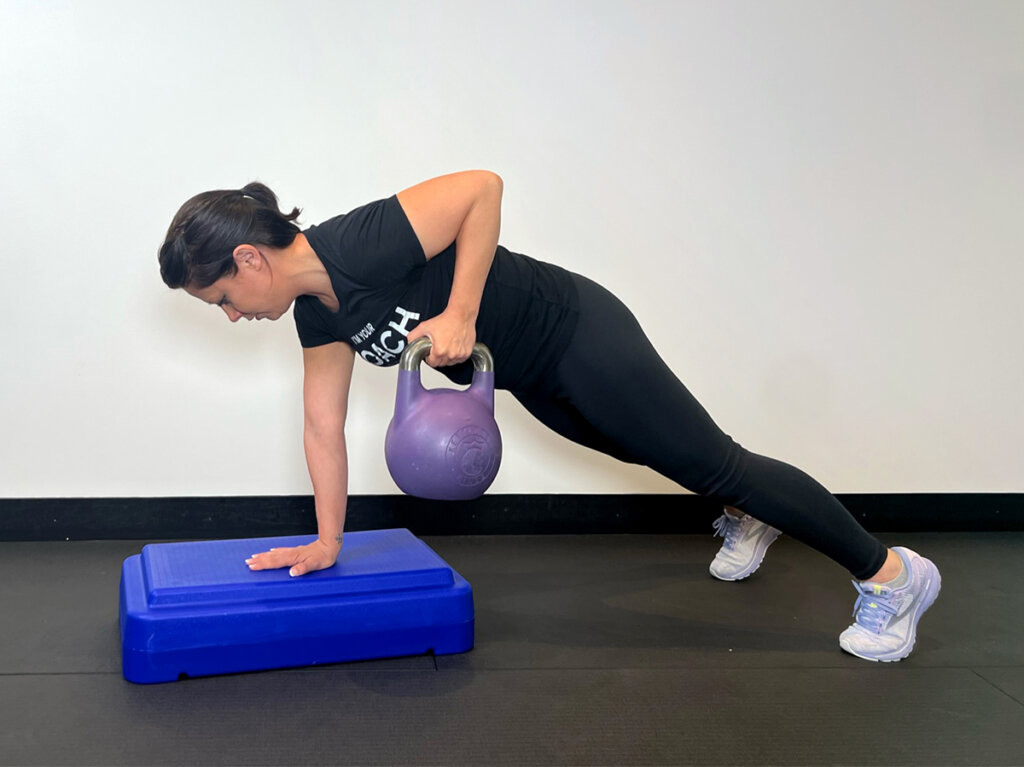
This is a great exercise for the back and core muscles, an area we could all benefit from strengthening. For this move, you have the option to add in a push-up before the row, although you will need two kettlebells to do so. If you only have one, skip the push-up and complete 10 reps on each side.
- Place each kettlebell on the ground, about shoulder-width apart. The kettlebell handle (or handles, if you’re using two) should be parallel with your feet, not perpendicular.
- Get into a high-plank position with your feet hip-width apart on the floor and rest one (or both hands) on the kettlebell handle(s). Complete one push-up or skip ahead to the next step.
- Keep your body in a straight line, then shift your weight evenly into your left foot and left hand, while still in plank position. Pull the kettlebell off the floor to your chest with your right hand while pinching your right shoulder blade and engaging your core muscles. There should be little to no weight in your right leg.
- Lower the kettlebell back to the floor with control. If you’re using one kettlebell, complete nine more reps before switching the kettlebell to your left hand and weight into your right side. If you have two kettlebells, alternate sides with each rep.
4. The Kettle Clean + Push Press
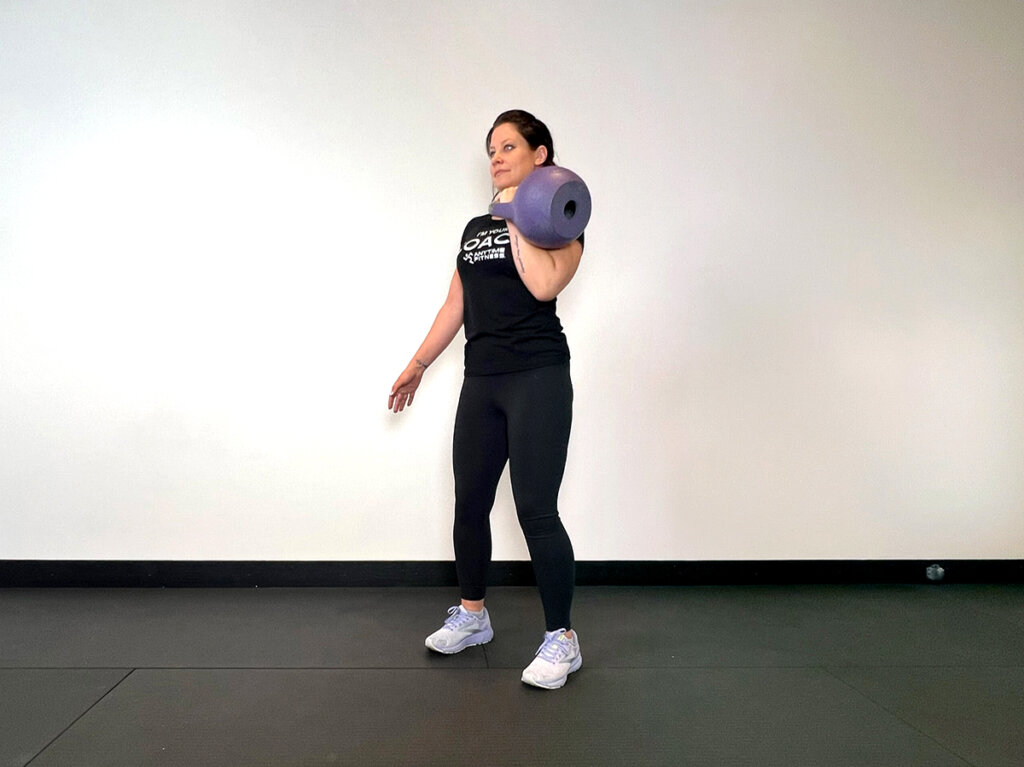
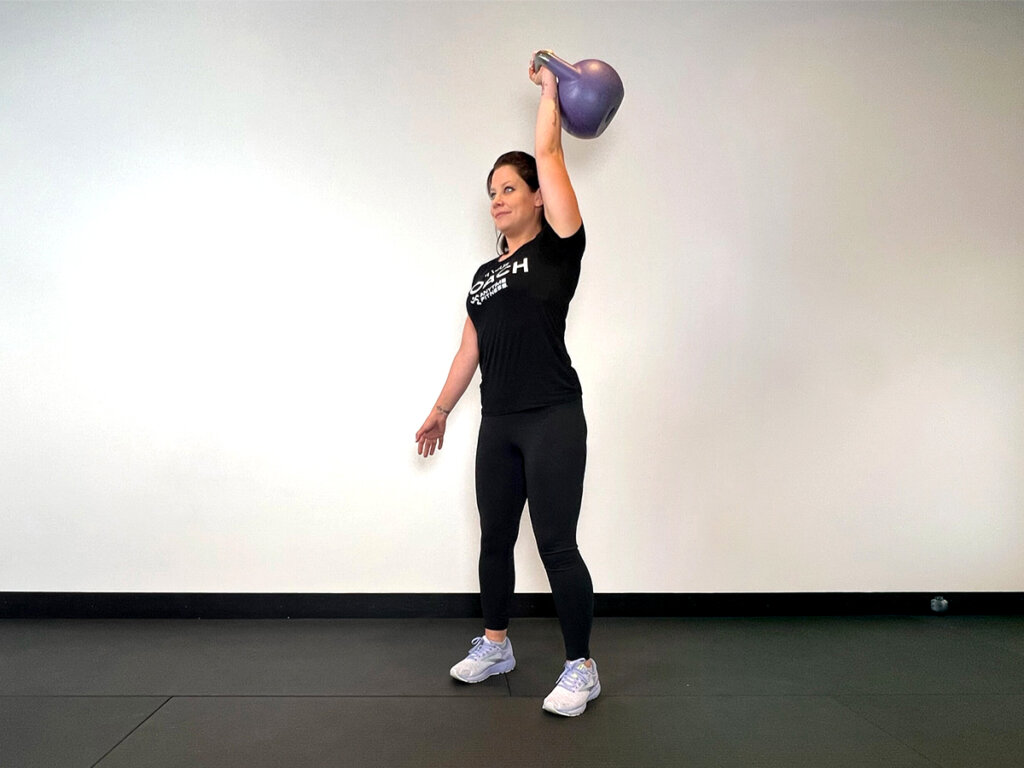
Also known as the “Hang Clean,” this is another popular full-body exercise that you’ll commonly come across in kettlebell training. While it may seem complex in the beginning, you will eventually get into the swing of it (ha) with a little practice. You have the option to combine the clean move and push press into one movement or do 10 cleans followed by 10 push presses on their own. Fun-fact: The clean is often used as a transition into other lifts such as the military press and the overhead press since they both start in the rack position.
As always, it’s better to use a light weight until you have the proper form down to reap the most benefits and prevent injury.
- Place your feet shoulder-width apart or wider and place the kettlebell on the floor in between your feet.
- Squat and bend your knees to reach down with your right hand to grab the kettlebell, being sure to keep your chest up and back flat. For stability, stick your left arm back behind you.
- Pull the kettlebell straight up to chest height (this is known as the rack position), using the driving momentum from your legs to lift the kettlebell. Your right elbow should be tucked in at your side and the kettlebell should be resting at your right shoulder.
- From here, complete the overhead press and slowly return it to rack position. Let the kettlebell fall back down towards the ground with control back to starting position.
5. The Kettlebell Figure 8 Squat
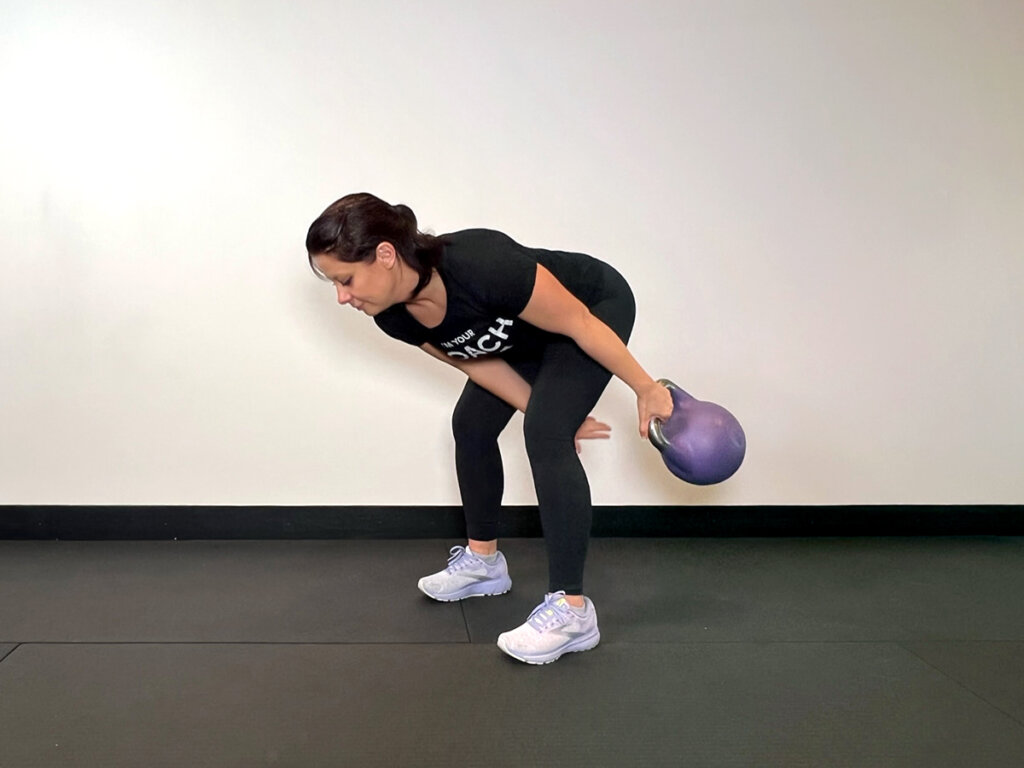
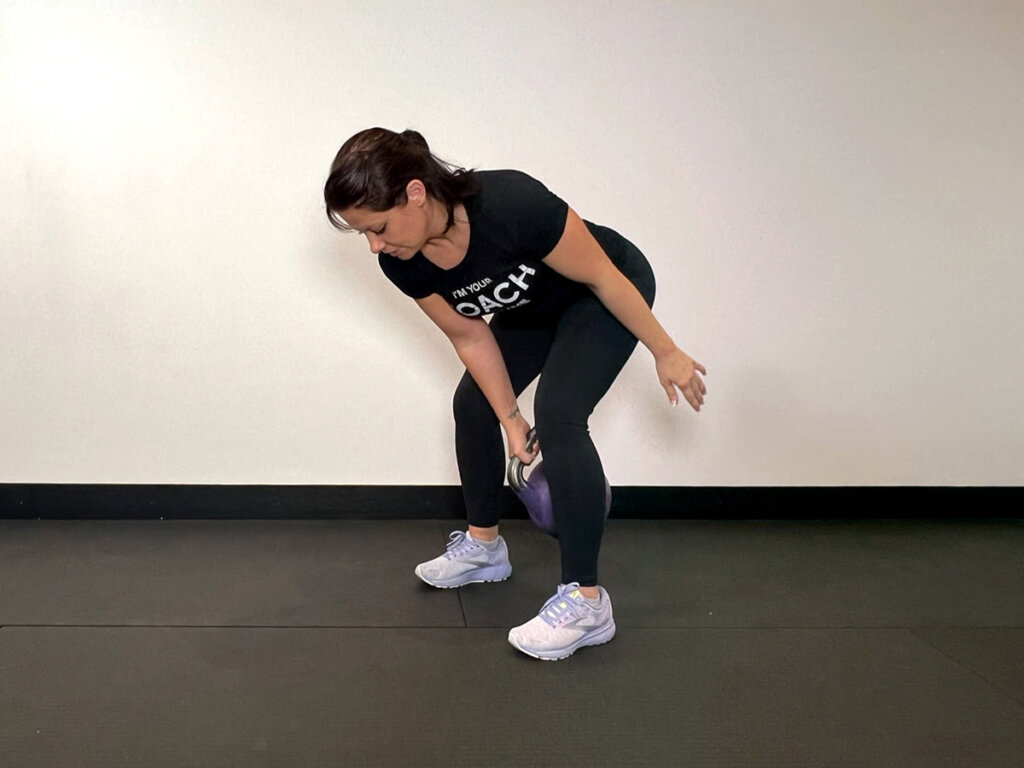
The squat figure 8 is a fun yet challenging full body move. For this exercise your feet should stay stationary for the entire set and remember to keep your back long and strong throughout the exercise. Complete 10 reps moving in one direction and then 10 more the opposite direction. Feel free to take a break in between to reset posture.
- Place your feet at least shoulder-width apart, if not wider, with a slight bend in your knees.
- Hold the kettlebell in your right hand off the floor at your right knee and bring your left arm back behind your left leg.
- Squat and pass the kettlebell to your left hand through your legs and bring it around to the front of your left leg as you extend your hips forward. You should have just squatted up to standing position.
- Squat back down and pass the kettlebell behind your right knee back to your right hand. Repeat!
6. The Kettlebell Halo
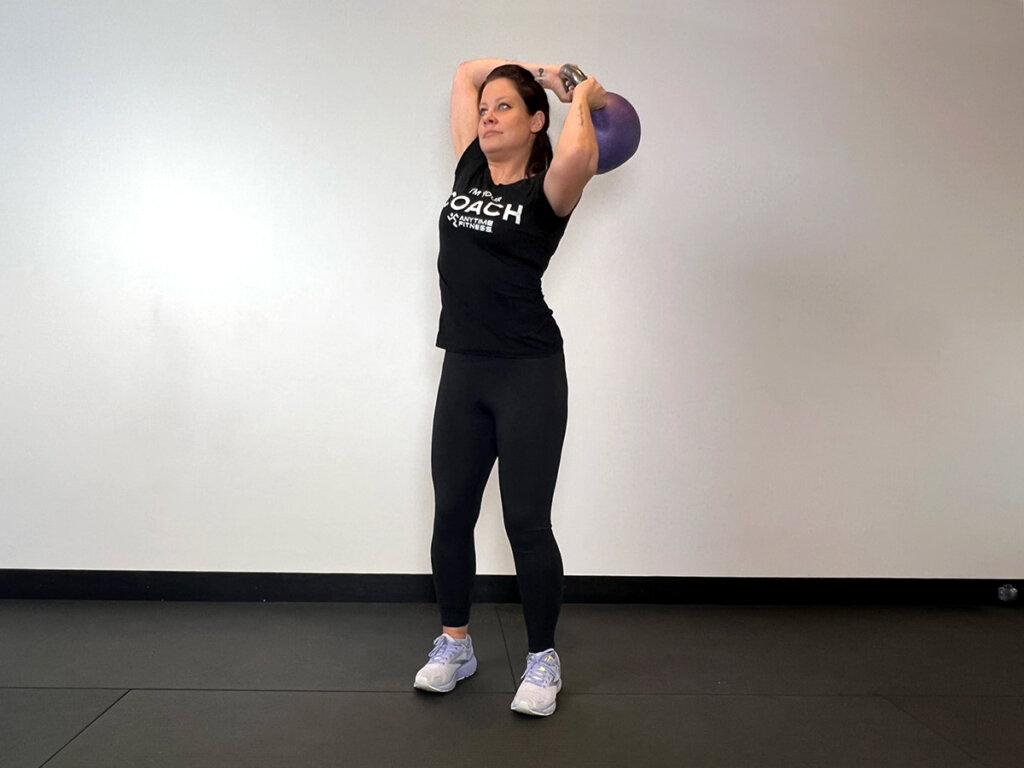
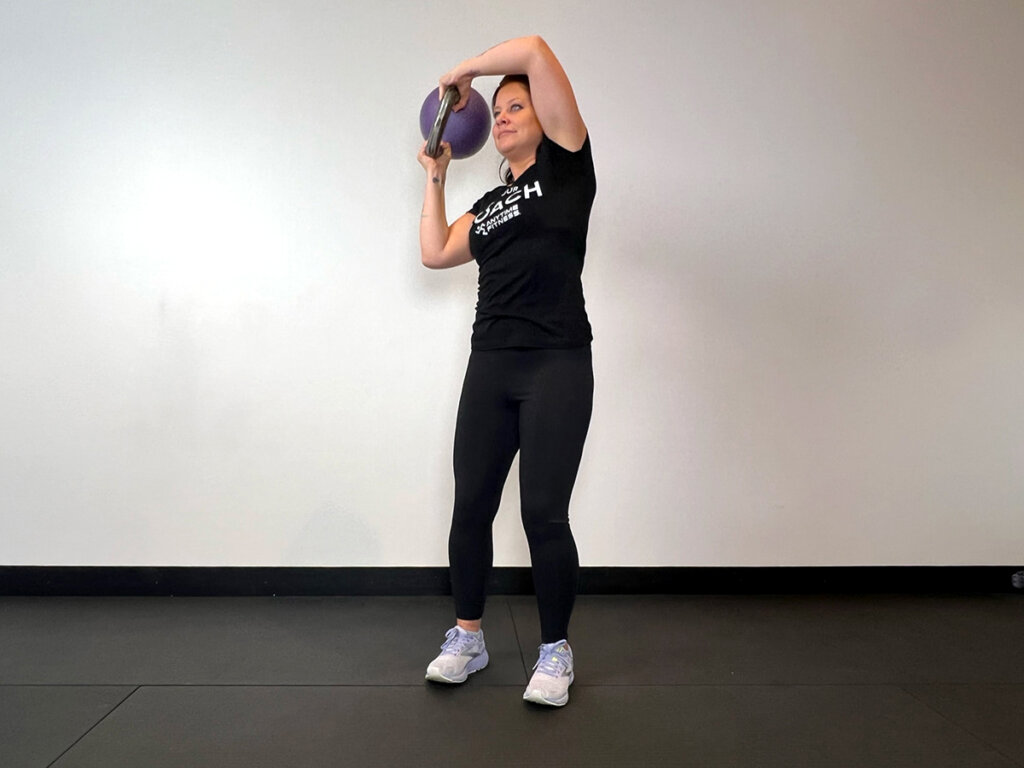
The halo is a great move to strength train your core muscles and improve mobility of your arms and upper body.
- Hold the kettlebell upside-down, with one hand on each side of the kettlebell handle. Place your feet shoulder-width or hip-width apart. Don’t lock your knees; keep a soft bend in them. Engage your core and keep your spine in a straight line for the entire movement to avoid arching your lower back.
- Bring the kettlebell back behind your head to the right, pointing your right and left elbow to the sky. Let the kettlebell ball drop down behind your neck.
- Finish the “halo” by bringing your arms around the left side of your head and back to the start position in front of you.
Once you’ve mastered this full-body kettlebell workout, you’ll be ready to advance to our two-circuit sprint full-body strength workout.
